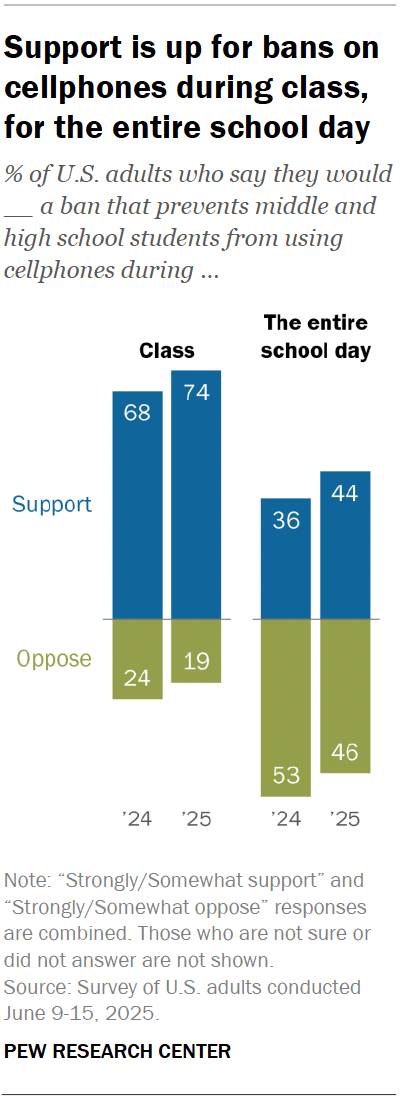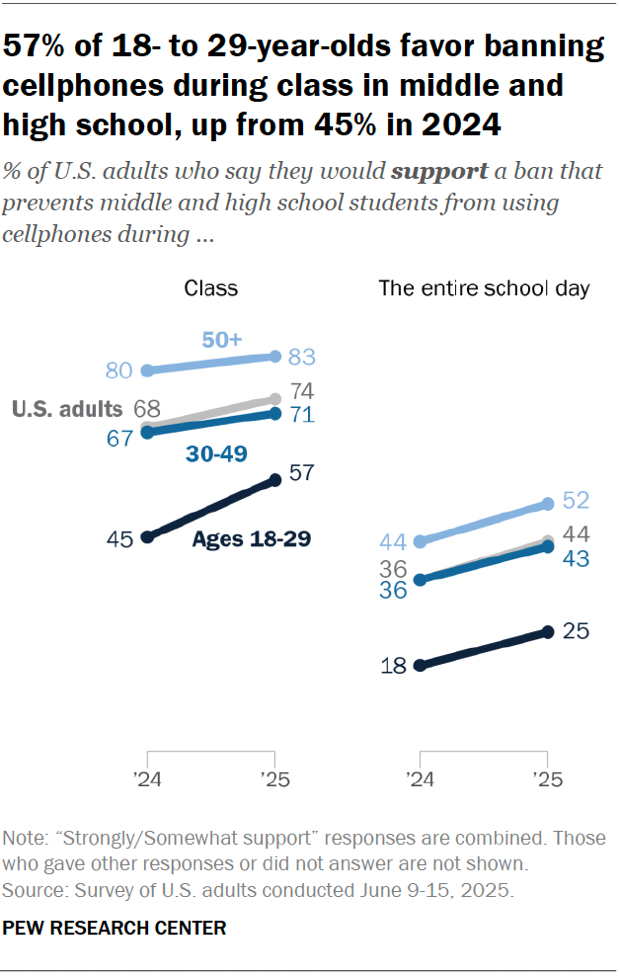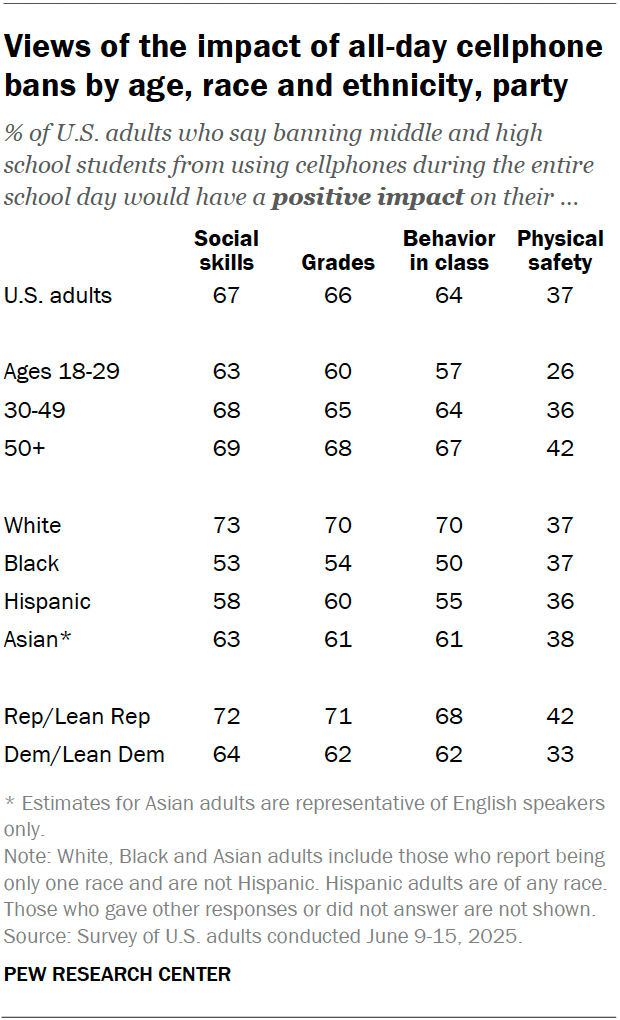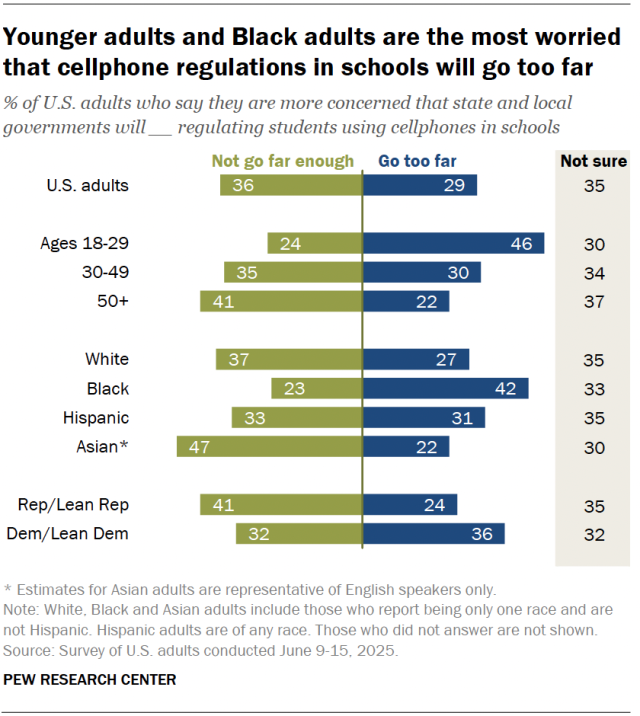
As the new school year approaches and lawmakers across the country decide whether to enact cellphone bans in schools, Americans’ support for such bans is inching up.
Today, 74% of U.S. adults say they would support banning middle and high school students from using cellphones during class, up from 68% last fall. Far fewer (19%) oppose classroom bans and 7% are unsure, according to a Pew Research Center survey conducted in June.

Support for all-day bans is also growing. More than four-in-ten Americans (44%) back bans on student cellphone use during the entire school day, up from 36% last fall.
Still, 46% of Americans oppose all-day bans. Another 10% are unsure.
Views by age

Majorities across all age groups now support banning cellphone use during class. That was not the case last year, when 45% of adults under 30 supported a ban. Over the past year, support particularly increased in this age group. Now, 57% of this group support a ban. This is still lower than support among those 50 and older (83%) and 30 to 49 (71%).
Support for all-day bans has grown across age groups since last year, though younger adults are less supportive than older people on this type of restriction, too.
Views by race and ethnicity
White (79%) and Asian (78%) adults are more likely than Hispanic (65%) and Black (59%) adults to support cellphone bans in class.
Additionally, 48% of White adults support all-day bans, roughly on par with the share of Asian adults (42%) but higher than the shares of Hispanic (39%) and Black (29%) adults who agree.
Views by party
Most Republicans and Democrats (including independents who lean to either party) stand behind cellphone bans during class, with support somewhat higher among Republicans than Democrats (78% vs. 71%).
Republicans are also more likely than Democrats to support banning cellphones during the entire school day (50% vs. 39%). Support for each type of ban has grown since last year in both parties.
Impact of cellphone bans on students
We also asked Americans about how an all-day cellphone ban would impact middle and high schoolers.

Majorities say banning cellphones during the entire school day would positively impact students’ social skills, grades and behavior in class. Much smaller shares say a ban would have a negative impact on each of these, and about one-in-five say it would have neither impact.
Fewer Americans (37%) say an all-day ban would have a positive impact on students’ physical safety. About a quarter (23%) say a ban would have a negative impact. Another 39% say it would have neither impact.
In 2024, we asked Americans why they support or oppose a cellphone ban in classrooms. Supporters largely said children would have fewer distractions and develop better social skills. Opponents emphasized parents’ need to contact their children when necessary.
Views by race and ethnicity

White adults are the most likely to say a cellphone ban during the entire school day would improve students’ social skills, grades and classroom behavior. For example, 73% of White adults say an all-day ban would positively impact social skills, higher than the shares of Black, Hispanic and Asian adults who agree.
Views are similar across racial and ethnic groups when it comes to impacts on students’ physical safety.
Views by age
Adults under 30 tend to be less likely than older people to say an all-day cellphone ban would positively impact students in these areas. For instance, 26% of those ages 18 to 29 say a ban would improve students’ physical safety, compared with 42% of those 50 and older.
The pattern is similar on the other three items we asked about.
Views by party
Republicans are somewhat more likely than Democrats to say an all-day cellphone ban would positively impact students across all four areas. For example, 71% of Republicans and 62% of Democrats say a ban would have a positive impact on students’ grades.
The role of government in regulating school cellphone use

Americans are slightly more worried about the government being too lax than too strict when regulating cellphone use in schools. Overall, 36% are more concerned that state and local governments won’t go far enough in their regulations, while 29% are more concerned that they might go too far. Another 35% are unsure.
Views by age
Younger adults are particularly concerned about government going too far in regulating cellphone use in schools, with 46% holding this view. By comparison, no more than three-in-ten adults in older age groups share this concern. Instead, older people are more likely to express concern that governments will not go far enough.
Views by race and ethnicity
Black adults are the most likely to be more concerned that governments will go too far. About four-in-ten (42%) say this, compared with fewer Hispanic (31%), White (27%) and Asian adults (22%).
In turn, White, Hispanic and especially Asian adults are more likely to express concern that governments will not go far enough.
Views by party
Democrats are more likely than Republicans to worry that state and local governments will go too far in their regulations (36% vs. 24%). Republicans are more concerned that governments will be too lax (41% vs. 32%).
Note: Here are the questions used for this analysis, the topline and the survey methodology.


